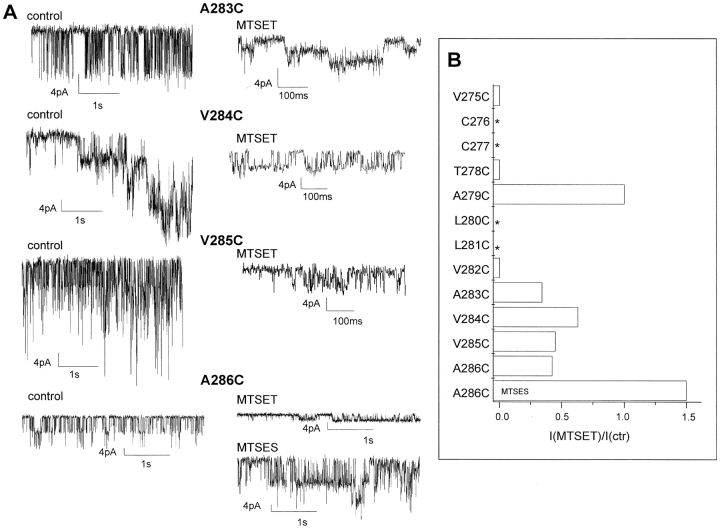Figure 6.
Single channel analysis of the effect of MTSET on IKCa channel mutants. (A) Inside-out single channel recordings obtained from IKCa mutants under low Ca2+ conditions at an internal MTSET concentration of 5 mM. The applied voltage −Vp corresponded to −140 mV throughout. Large negative potentials were used in these experiments to optimize the signal to noise ratio, the current jump amplitude at −60 mV being barely detectable (<0.3 pA) after MTSET treatment except for the A286C mutant. The action of MTSET on 283C and 286C is seen to result in a substantial increase in open channel probability in accordance with the increase in mean current observed with the A283C and A286C mutants. (B) Bar graph representation of the effect of MTSET (5 mM) and MTSES (5mM) on the unitary current amplitude of IKCa mutants. I(MTSET) and I(ctr) correspond to the unitary current amplitude measured at −140 mV in the presence or absence of MTSET or MTSES (5 mM) respectively. * refers to endogenous cysteine or nonfunctional mutants as mentioned in Fig. 4. A ratio of 1 indicates an absence of MTSET- or MTSES-based effect on the channel unitary conductance. As seen, internal application of MTSET caused a near inhibition of the unitary current amplitude for the V275C, T278C, and V282C mutant channels. A partial inhibition ranging from 40% (V284C) to 70% (A283C) was observed with mutants obtained by cysteines substitution of the residues in the COOH-terminal region of S6 (A283–A286). In contrast, the application of the negatively charged MTSES reagent on A286C resulted in an increased unitary current amplitude. These observations suggest that the presence of charged groups at the cytoplasmic entrance of the pore can modulate the exit rate of K+ from the channel cavity into the cytosolic solution.

